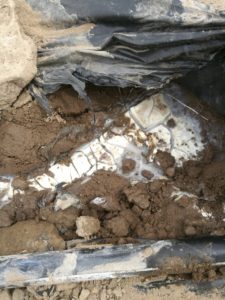When mixing fertilizers, it is important to check fertilizer compatibility before application. If incompatible fertilizers are mixed, they form insoluble precipitations that can clog drip emitters and damage sprayers used to apply foliar fertilizers (Figure 1.). This article discusses a few scenarios for which special attention should be paid on the solubility of mixed fertilizers.
Scenario 1. A grower is using 20-20-20, a complete fertilizer to fertigate tomatoes. To prevent blossom end rot, he decided to add calcium nitrate in his fertigation program. However, problems may be caused by the application of these two fertilizers. The reason is that calcium from calcium nitrate and phosphate from ammonium phosphate in the complete fertilizer may form calcium phosphate, which is insoluble in water.
Scenario 2. A soil test indicates that tomato plants are low in magnesium. Epson salt (magnesium sulfate) is recommended to correct magnesium deficiency. The grower should avoid applying Epson salt together with complete fertilizers because magnesium from Epson salt forms an insoluble compund when it meets phosphate in the complete fertilizer. In both cases, calcium nitrate and magnesium sulfate should be applied separately with the complete fertilizers.
Scenario 3. The grower wants to apply both calcium nitrate and magnesium sulfate through drip to add calcium and magnesium during the season. These two fertilizers also should not be applied together because calcium nitrate and magnesium sulfate form calcium sulfate, which has a low solubility.
Scenario 4. A grower wants to foliar apply a high phosphorus fertilizer at blooming stage to increase flowering and help fruit set. He also wants to apply a foliar micronutrient fertilizer solution because plant tissue test indicates plants are low in Boron and Zinc. However, several cations (such as Boron, Zinc, Copper, Iron etc.) in the foliar fertilizer solution are insoluble with phosphate, especially if they are not in a chelated form. The high phosphorus fertilizer should not be applied together with the foliar nutrient solution.
It is impossible to list all the incompatible fertilizers. The best approach is to conduct a jar test before mixing fertilizers. When doing a jar test, the fertilizers should be mixed in the same concentration as intended to be used. If you see the mixed solution has a milky appearance, the fertilizers should not be mixed and applied together.
